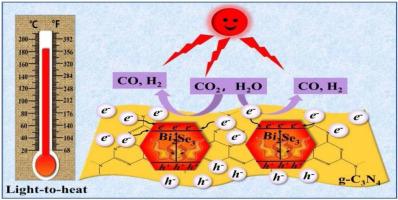Applied Catalysis B: Environment and Energy ( IF 22.1 ) Pub Date : 2020-06-11 , DOI: 10.1016/j.apcatb.2020.119232 Yanhong Huang , Kai Wang , Ting Guo , Jun Li , Xiaoyong Wu , Gaoke Zhang

|
Solar-energy-driven CO2 conversion into high-valued fuels has been considered as a promising strategy to alleviate the greenhouse effect and energy crisis problems. However, the rapid charge recombination, poor light utilization and low selectivity, etc. still limit the efficiency of photocatalytic CO2 reduction. In this work, a novel 2D/2D Bi2Se3/g-C3N4 heterojunction composite has been developed to investigate the improved photocatalytic activity towards CO2 reduction selectively. Fortunately, an intimate interaction was formed between 2D Bi2Se3 and 2D g-C3N4, which is very beneficial for the charge separation and transfer. In this composite, Bi2Se3 not only acted as a cocatalyst liked role, but also played as an extra heater for photocatalytic reaction by effective photo-to-heat conversion. As expected, the 2D/2D Bi2Se3/g-C3N4 composite presented much improved photocatalytic ability for CO2 reduction to CO, which is about 6.3 times higher than that of pristine g-C3N4 under the irradiation of full spectrum. Notably, the product from CO2 reduction was nearly 100% CO without other carbon products, and the selectivity for CO was greater than 90% over H2 evolution. The experimental tests and DFT calculations confirmed that the superiority of photocatalytic CO2 reduction ability of Bi2Se3/g-C3N4 composite over other counterparts should be attributed to the synergetic effect of highly improved charge separation and strong photo-to-heat conversion efficiency. Meanwhile, the CO2 reduction process was studied by in-situ FTIR in detail. The as-proposed composite in this work might provide a potential strategy for developing high efficiency of photocatalytic CO2 reduction to valuable fuels.
中文翻译:

具有高界面电荷分离和光热转换效率的2D / 2D Bi 2 Se 3 / gC 3 N 4纳米复合材料的构建,用于选择性光催化还原CO 2
太阳能驱动的CO 2转化为高价值燃料已被认为是缓解温室效应和能源危机问题的有前途的战略。但是,快速的电荷复合,光利用率差和选择性低等仍然限制了光催化CO 2还原的效率。在这项工作中,已开发出一种新颖的2D / 2D Bi 2 Se 3 / gC 3 N 4异质结复合材料,以研究对CO 2还原选择性提高的光催化活性。幸运的是,在2D Bi 2 Se 3和2D gC 3 N 4之间形成了紧密的相互作用。,这对电荷的分离和转移非常有利。在这种复合物中,Bi 2 Se 3不仅起到助催化剂的作用,而且还通过有效的光热转换充当光催化反应的额外加热器。如所预期的,2D / 2D Bi 2 Se 3 / gC 3 N 4复合材料表现出大大提高的将CO 2还原为CO的光催化能力,在全光谱辐射下比原始gC 3 N 4高约6.3倍。值得注意的是,CO 2的产物在没有其他碳产物的情况下,CO的还原率几乎为100%,并且在H 2放出过程中,CO的选择性大于90%。实验测试和DFT计算证实,Bi 2 Se 3 / gC 3 N 4复合材料的光催化CO 2还原能力优于其他复合物的原因应归功于高度改进的电荷分离和强大的光热转换的协同效应。效率。同时,通过原位FTIR对CO 2的还原过程进行了详细的研究。这项工作中提议的复合材料可能为开发高效率的光催化CO 2提供潜在的策略。 减少到有价值的燃料。


























 京公网安备 11010802027423号
京公网安备 11010802027423号